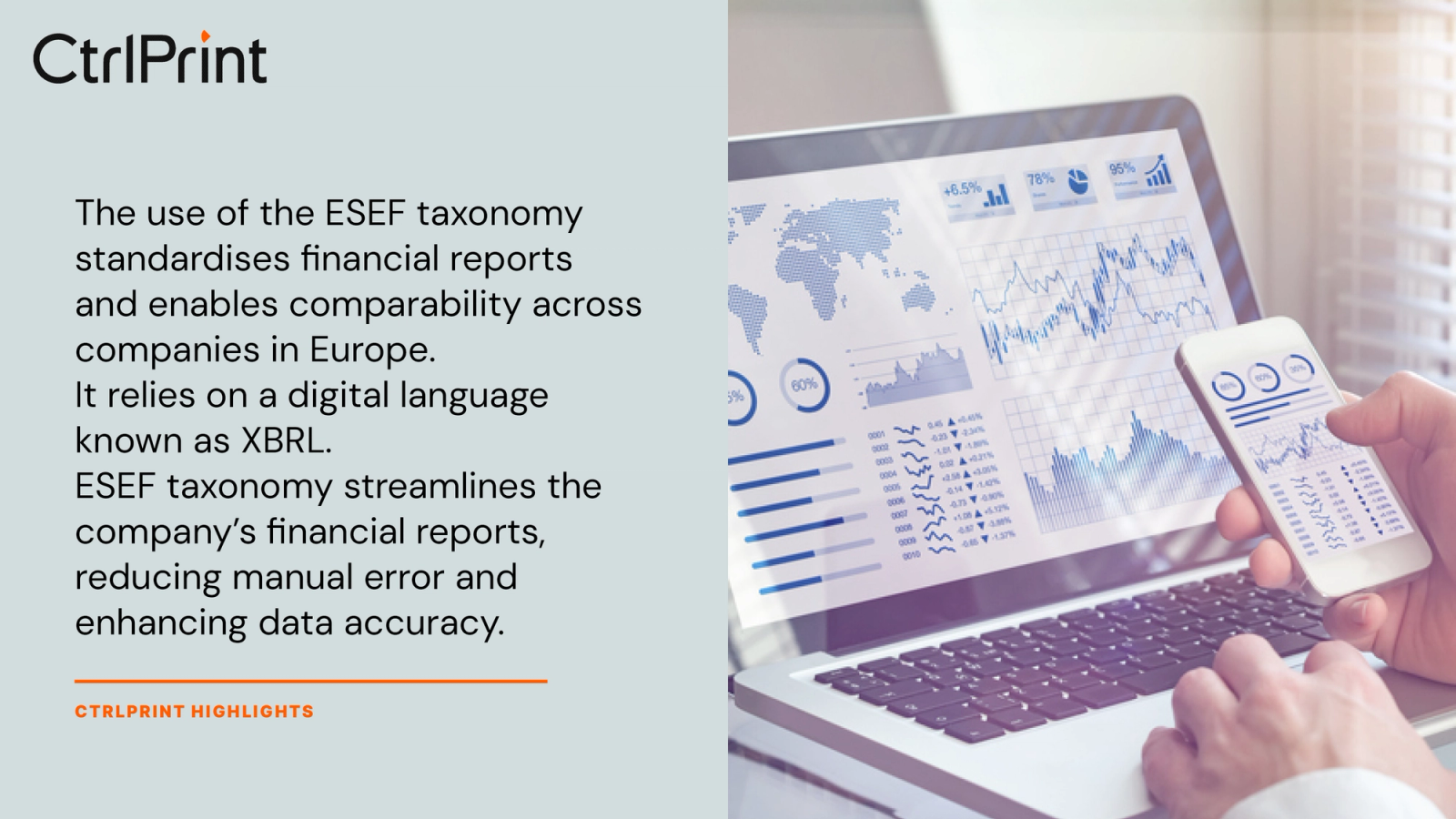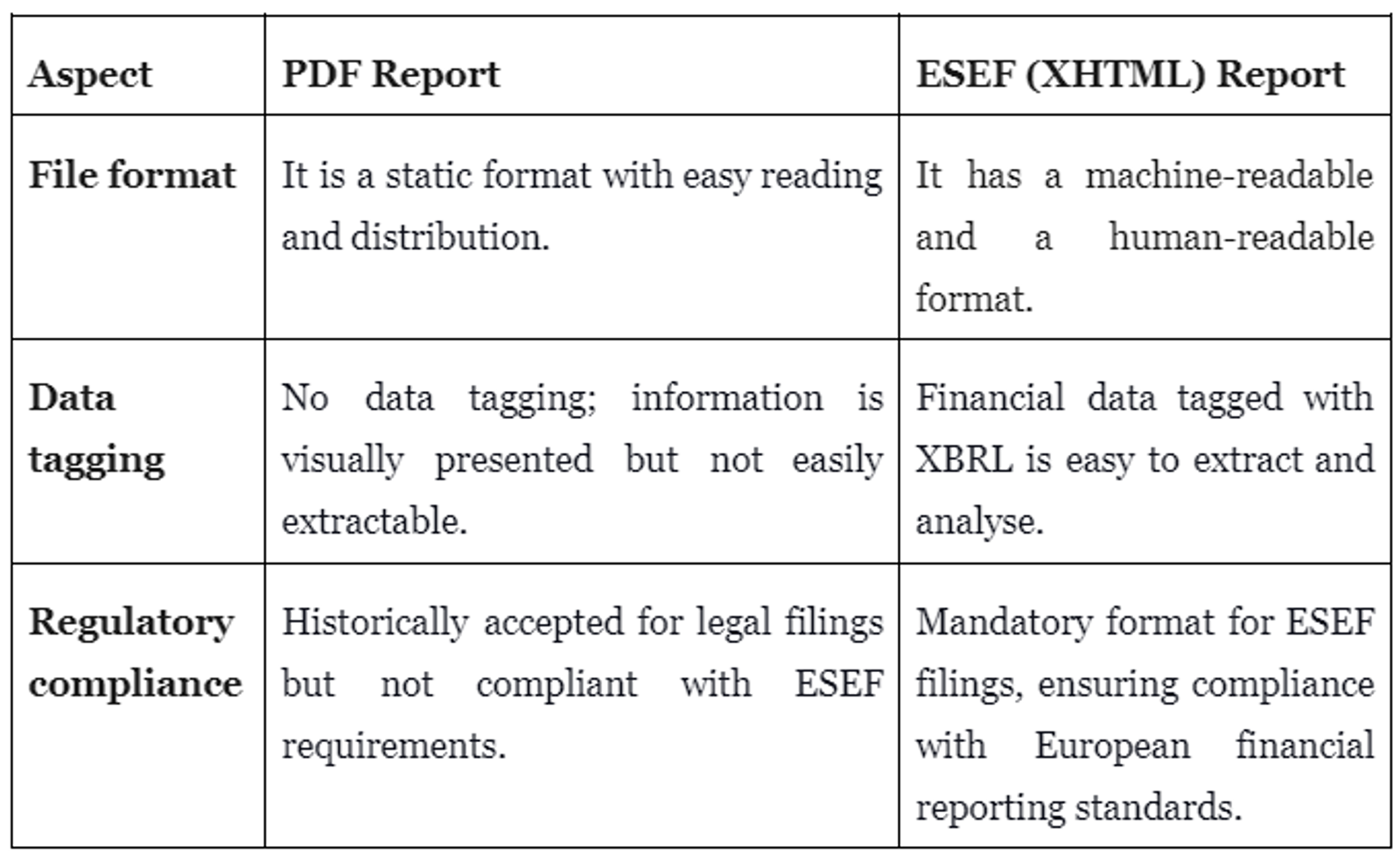PDF reporting has been for a while a thing of the past, and companies must now follow the latest ESEF regulations: this financial reporting ensures transparency and accessibility of financial information to the stakeholders.
The listed companies must prepare and submit their financial reports in this digital format, which is both human-readable and machine-readable. You can achieve this with the CtrlPrint XBRL-certified software for financial & sustainability tagging. In this article, we will shed some light on ESEF, and answer questions such as: what is ESEF taxonomy, what is ESEF tagging, who has to comply with ESEF, and more.
Before we begin, if you are in need of a corporate reporting software to submit your ESEF reports, check how CtrlPrint can help you deliver compliant and captivating reports now.

Key aspects of ESEF reporting
Annual financial reports must be submitted in a specific digital format to meet the ESEF reporting requirements.
ESEF reporting improves three main factors in the financial data: transparency, accessibility, and comparability.
Understanding the ESEF reporting can be overwhelming since there are many aspects to this reporting method, so here is a quick overview to help you understand it better:
- All EU-listed companies, with securities listed on regulated markets, must meet the ESEF requirements for financial reporting.
- Prepare the financial reports in XHTML (Extensible HyperText Markup Language) format. It is easily readable, and you can open it in any web browser.
- Tag the financial statements in the reports with inline extensible Business Reporting Language (Inline XBRL). Doing so would make the financial data machine readable. Hence, data extracted by computers can be analysed efficiently.
- As reports must follow the International Financial Reporting Standards (IFRS) tagging financial data across all companies using the ESEF taxonomy is mandatory.
- Your reports should be signed off by auditors to ensure compliance.
- File and submit your financial reports according to ESEF requirements to your regulatory authority, which varies from country to country. Authorities will then further ensure the authenticity and accuracy of your submissions.
What is the ESEF mandate?
The ESEF mandate, set by ESMA, requires the EU-regulated market issuers to prepare annual financial reports using the ESEF format. The standard format makes reports both machine-readable and more accessible.
What is ESEF Tagging? Is there a difference between detailed tagging and block tagging?
ESEF tagging involves organising financial data according to the ESEF taxonomy derived from the IFRS taxonomy. There are two main steps of the IXBRL tagging process for ESEF.
Tagging primary financial statements: this is the detailed tagging of main financial statements such as income statements and balance sheets.
Block tagging of notes: this involves tagging of larger pieces of text and tables as a whole, rather than individual data points.
Process of Block Tagging:
Block tagging is the application of iXBRL tags to notes and accounting policies.
As explained above, in block tagging one has to tag the entire sections of that text. It does not involve tagging every piece of financial data as in the case of tagging primary financial statements.
What is the ESEF Taxonomy?
The use of the ESEF taxonomy standardises financial reports and enables comparability across companies in Europe. It relies on a digital language known as XBRL. ESEF taxonomy streamlines the company’s financial reports, reducing manual error and enhancing data accuracy.
The entire process results in financial statements that are consistent, easily readable, and comparable, making it easy for investors, regulators, and other stakeholders to analyse the financial position of the companies.
The ESEF taxonomy comes in various languages to fulfil the needs of different European Countries.

Who has to comply with ESEF, and why is it mandatory?
From January 2020, every company with securities in the European Union has to publish their financial reports in digital format for fiscal years beginning on or after 1 January, to meet the guidelines of ESMA. So, companies with securities listed on the market in the EU, such as Euronext, must comply with ESEF.
It is mandatory for several reasons, let's see the main ones;
- When you make the financial reports machine-readable via iXBRL tagging, the investors and regulatory authorities can easily access the report.
- ESEF allows a quick comparison of the financial data across different EU companies due to one standardised reporting format.
- The ESEF format is a step towards modernising EU capital markets with digital information.
- On top of all, since the ESEF reporting is digital, it leads to sustainability. This format has reduced the reliance of companies on paper and carbon footprint. So, it is the best alternative to traditional paper-based reporting.
- The entire reporting format fosters efficient analysis, prompt decision-making, and better compliance in the EU financial market.
- It is also beneficial to prevent potential errors and avoid manual efforts. Hence, the automated preparation and analysis saves time and energy.
The companies can use the ESEF taxonomy, and ESEF reporting software and solutions to comply with the ESMA’s requirements. The inability to comply with the rules might result in penalties or other reputational damages.
ESEF compliance checklist for 2024
Here is a checklist to help you ensure your financial reports are according to the ESEF standards in 2024;
- It is vital to understand the ESEF filing requirements, so make sure you familiarise yourself with the mandate and its goals.
- The company should review the latest ESMA guidance on ESEF filing for 2024.
- Keep the reporting team updated about the changes and updates to the ESEF taxonomy and tagging requirements.
- The primary financial statements should be converted to XHTML and tagged using iXBRL.
- The company should use the updated ESEF taxonomy for tagging, unless advised otherwise by their auditors.
- Apply the iXBRL tags correctly, complying with ESEF standards.
- Extend tags to notes and disclosures. It is mandatory to follow the block tagging needs and other requirements.
- Use the ESEF validation tools to spot any errors or inconsistencies.
- You should verify the tagged information before submitting the report.
- You must meet the filing requirements of your local authority.
- Make sure you submit the ESEF-compliant report via proper channels.
- Keep up to date with the latest news on the ESEF taxonomy. The companies have no other option except to comply with the ESEF rules.
How does the ESEF report differ from the PDF Report?
If you’re wondering what the differences are between the previous PDF reporting and ESEF-compliant XHTML reports, we broke it down for you in the below table.

What´s the impact of ESEF on accountants and financial reporting specialists?
Financial specialists might have a responsibility to learn new skills in the field after the advent of ESEF. Unless their company decide to hire consultants to comply with ESEF reporting, they must know how the software works in preparation for XHTML reports and the tagging using iXBRL.
We would recommend seeing this as a learning opportunity as they need to ensure the accuracy of tagging and comply with the rules of the financial reports.
Moreover, the preparation of digital reports results in reduced human errors, and it can also be beneficial in saving time. Financial specialists could then invest the saved time in the most analytical aspects of the financial reports.
Using the right software is also beneficial to make this process as smooth and efficient as possible. At CtrlPrint, with more than 25 years of experience in corporate and financial reporting, we have developed great tools to aid you with your ESEF reports and more. Contact us today to access our demo or get in touch with our support team and the corporate reports experts at CtrlPrint!

What´s the impact of ESEF on Auditors?
Auditors must verify that the client’s financial reports comply with ESEF requirements. They can do this by using a digital tool to review the XBRL report and verify that there are no errors, calculation inconsistencies or hidden tags in the final report.
Additionally, the auditors need to be technically proficient in order to work with XHTML and XBRL to navigate and interpret ESEF reports.
Our final remarks on ESEF regulations
Now that you know how essential the ESEF taxonomy is in standardising financial statements, we hope you’ll be ready to submit a compliant report, keeping your business safe from severe penalties.
Complying with ESEF also helps companies enhance data accuracy and transparency, therefore it is fundamental for companies to keep themselves updated with the evolving taxonomy, and use the right corporate software for their ESEF reports. If you’re still looking for the ideal reporting software, check how CtrlPrint can help you be compliant with ESEF, and other regulatory requirements such as CSRD and more.

